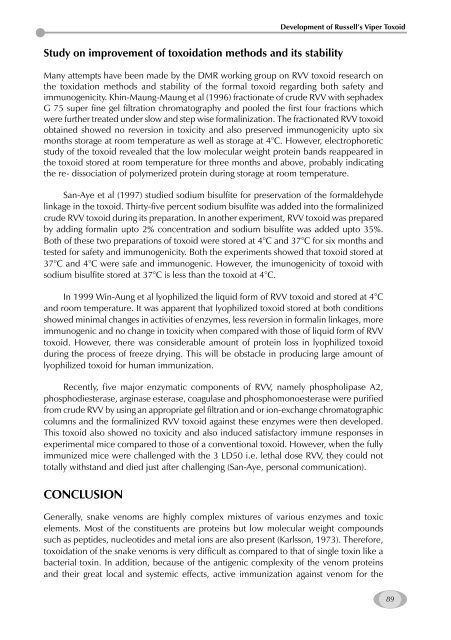Management of Snakebite and Research Management of Snakebite ...
Management of Snakebite and Research Management of Snakebite ...
Management of Snakebite and Research Management of Snakebite ...
You also want an ePaper? Increase the reach of your titles
YUMPU automatically turns print PDFs into web optimized ePapers that Google loves.
Study on improvement <strong>of</strong> toxoidation methods <strong>and</strong> its stability<br />
Many attempts have been made by the DMR working group on RVV toxoid research on<br />
the toxidation methods <strong>and</strong> stability <strong>of</strong> the formal toxoid regarding both safety <strong>and</strong><br />
immunogenicity. Khin-Maung-Maung et al (1996) fractionate <strong>of</strong> crude RVV with sephadex<br />
G 75 super fine gel filtration chromatography <strong>and</strong> pooled the first four fractions which<br />
were further treated under slow <strong>and</strong> step wise formalinization. The fractionated RVV toxoid<br />
obtained showed no reversion in toxicity <strong>and</strong> also preserved immunogenicity upto six<br />
months storage at room temperature as well as storage at 4°C. However, electrophoretic<br />
study <strong>of</strong> the toxoid revealed that the low molecular weight protein b<strong>and</strong>s reappeared in<br />
the toxoid stored at room temperature for three months <strong>and</strong> above, probably indicating<br />
the re- dissociation <strong>of</strong> polymerized protein during storage at room temperature.<br />
San-Aye et al (1997) studied sodium bisulfite for preservation <strong>of</strong> the formaldehyde<br />
linkage in the toxoid. Thirty-five percent sodium bisulfite was added into the formalinized<br />
crude RVV toxoid during its preparation. In another experiment, RVV toxoid was prepared<br />
by adding formalin upto 2% concentration <strong>and</strong> sodium bisulfite was added upto 35%.<br />
Both <strong>of</strong> these two preparations <strong>of</strong> toxoid were stored at 4°C <strong>and</strong> 37°C for six months <strong>and</strong><br />
tested for safety <strong>and</strong> immunogenicity. Both the experiments showed that toxoid stored at<br />
37°C <strong>and</strong> 4°C were safe <strong>and</strong> immunogenic. However, the imunogenicity <strong>of</strong> toxoid with<br />
sodium bisulfite stored at 37°C is less than the toxoid at 4°C.<br />
In 1999 Win-Aung et al lyophilized the liquid form <strong>of</strong> RVV toxoid <strong>and</strong> stored at 4°C<br />
<strong>and</strong> room temperature. It was apparent that lyophilized toxoid stored at both conditions<br />
showed minimal changes in activities <strong>of</strong> enzymes, less reversion in formalin linkages, more<br />
immunogenic <strong>and</strong> no change in toxicity when compared with those <strong>of</strong> liquid form <strong>of</strong> RVV<br />
toxoid. However, there was considerable amount <strong>of</strong> protein loss in lyophilized toxoid<br />
during the process <strong>of</strong> freeze drying. This will be obstacle in producing large amount <strong>of</strong><br />
lyophilized toxoid for human immunization.<br />
Recently, five major enzymatic components <strong>of</strong> RVV, namely phospholipase A2,<br />
phosphodiesterase, arginase esterase, coagulase <strong>and</strong> phosphomonoesterase were purified<br />
from crude RVV by using an appropriate gel filtration <strong>and</strong> or ion-exchange chromatographic<br />
columns <strong>and</strong> the formalinized RVV toxoid against these enzymes were then developed.<br />
This toxoid also showed no toxicity <strong>and</strong> also induced satisfactory immune responses in<br />
experimental mice compared to those <strong>of</strong> a conventional toxoid. However, when the fully<br />
immunized mice were challenged with the 3 LD50 i.e. lethal dose RVV, they could not<br />
totally withst<strong>and</strong> <strong>and</strong> died just after challenging (San-Aye, personal communication).<br />
CONCLUSION<br />
Development <strong>of</strong> Russell’s Viper Toxoid<br />
Generally, snake venoms are highly complex mixtures <strong>of</strong> various enzymes <strong>and</strong> toxic<br />
elements. Most <strong>of</strong> the constituents are proteins but low molecular weight compounds<br />
such as peptides, nucleotides <strong>and</strong> metal ions are also present (Karlsson, 1973). Therefore,<br />
toxoidation <strong>of</strong> the snake venoms is very difficult as compared to that <strong>of</strong> single toxin like a<br />
bacterial toxin. In addition, because <strong>of</strong> the antigenic complexity <strong>of</strong> the venom proteins<br />
<strong>and</strong> their great local <strong>and</strong> systemic effects, active immunization against venom for the<br />
89









